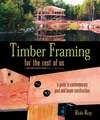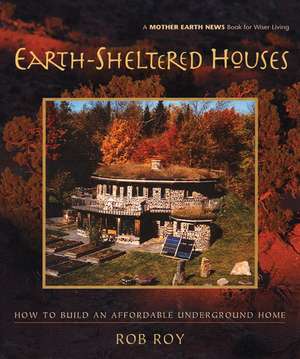Earth-Sheltered Houses: How to Build an Affordable Underground Home: Mother Earth News Wiser Living Series
Autor Rob Royen Limba Engleză Paperback – 30 apr 2006
Earth-Sheltered Houses is a practical guide for those who want to build their own underground home at moderate cost. It describes the benefits of sheltering a home with earth, including the added comfort and energy efficiency from the moderating influence of the earth on the home’s temperature (keeping it warm in the winter and cool in the summer), along with the benefits of low maintenance and the protection against fire, sound, earthquake, and storm afforded by the earth. Extra benefits from adding an earth or other living roof option include greater longevity of the roof substrate, fine aesthetics, and environmental harmony.
The book covers all of the various construction techniques involved, including details on planning, excavation, footings, floor, walls, framing, roofing, waterproofing, insulation, and drainage. Specific methods appropriate for the inexperienced owner/builder are a particular focus and include:
- Pouring one’s own footings and/or floor
- The use of dry-stacked (surface-bonded) concrete block walls
- Post-and-beam framing
- Plank-and-beam roofing
- Drainage methods and self-adhesive waterproofing membranes
Rob Roy is a former contractor with 27 years of experience and 12 previous books to his credit, including Cordwood Building and Timber Framing for the Rest of Us. An expert on underground building, he founded the Earthwood Building School in 1981 with his wife, Jaki, and is frequently a speaker at events throughout North America.
Din seria Mother Earth News Wiser Living Series
-
 Preț: 129.86 lei
Preț: 129.86 lei -
 Preț: 182.55 lei
Preț: 182.55 lei -
 Preț: 115.32 lei
Preț: 115.32 lei -
 Preț: 124.04 lei
Preț: 124.04 lei -
 Preț: 210.55 lei
Preț: 210.55 lei -
 Preț: 207.84 lei
Preț: 207.84 lei -
 Preț: 265.61 lei
Preț: 265.61 lei - 36%
 Preț: 95.81 lei
Preț: 95.81 lei
Preț: 108.81 lei
Preț vechi: 209.55 lei
-48% Nou
20.83€ • 22.63$ • 17.51£
Carte indisponibilă temporar
Specificații
ISBN-10: 0865715211
Pagini: 255
Ilustrații: 80 Color and B&W illustrations and photographs
Dimensiuni: 200 x 227 x 17 mm
Greutate: 0.55 kg
Editura: New Society Publishers
Seria Mother Earth News Wiser Living Series
Locul publicării:Canada
Notă biografică
Author/editor Rob Roy has been building, researching and teaching about cordwood masonry for 25 years and, with his wife, started Earthwood Building School in 1981. He has written ten books on alternative building, presented four videos-including two about cordwood masonry-and has taught cordwood masonry all over the world.
Descriere
Cuprins
Acknowledgments
Introduction
Chapter 1 - Earth-Sheltered Design Principles
Earth as Thermal Mass
The Importance of Insulation
Insulation in the North
Insulation in the South
The Earth Roof Factor
How Much Does it Weigh?
Simplicity of Design
Types of Earth-Sheltered Designs
Egress and Fenestration Code Considerations
The Original Log End Cave Plan
The 40 × 40' Log End Cave Plan
The Earthwood Plan
Using "Marginal" Land
Design Around Bargains
Plans and Models
Chapter 2 - Siting and Excavation
Flat Site Excavation Calculations
Log End Cave: "A Gentle, South-Facing Slope"
Log End Cave: Laying out the Excavation
Earthwood: Site Work
Chapter 3 - Foundations
Log End Cave: Laying Out the Footings
Log End Cave: Insulating the Footings
Resisting Lateral Load on the Wall
The Frost Wall
Earthwood: The Floating Slab
The "Monolithic" Floating Slab
Earthwood: Laying out and Digging the Footings Tracks
Log End Cave: Forming the Footings
Reinforcing Bar (Rebar)
Earthwood: A Round Footing
Chapter 4 - The Floor
A Wooden Floor
The Concrete Floor
Earthwood: Insulation
In-Floor Radiant Heating
Under-Floor Plumbing
Under-Floor Electrical
Under-Stove Vents
Log End Cave: The Fence
The Floor Pour: A Final Checklist
Log End Cave: Pouring the Floor
Earthwood: Preparation for the Floor
Earthwood: Forming and Pouring the Buttresses
Earthwood: Pouring the Floor
Chapter 5 - External Walls
Conventionally Mortared Concrete Blocks
Stone Masonry
Cordwood Masonry
Poured Concrete
Pressure-Treated Wood Foundations
Rammed-Earth Tire Walls
Mike Oehler's "PSP" Method
Surface-Bonded Blocks
Log End Cave: The Walls
Log End Cave: Finishing the Top of the Block Wall
Simultaneous Events at Earthwood
Chapter 6 - Timber Framing
About Posts and Planks
Design Considerations for Rafters
Bending and Shear
Sources of Timbers
Timber Framing for Earth-Sheltered Housing
Log End Cave: Timber Framing
Installing Posts on Concrete
Log End Cave: Plank-and-Beam Roofing
Log End Cave: Installing the Planking
Earthwood: Timber Framing
Earthwood: The Floor Joists
Earthwood: Decking
Earthwood: Upstairs Post-and-Beam Frame
Earthwood: Rafters
Chapter 7 - Waterproofing, Insulation & Drainage
Waterproofing Options
In Search of the Perfect Membrane...
Waterproofing Vertical Walls
Waterproofing Roofs: The Drip Edge
Earthwood: Waterproofing the Roof
Sidewall Insulation
Roofing Insulation
Earthwood: Insulating the Roof
Drainage
Footing Drains
Draining the Sidewalls
Drainage Mats (Composites)
Roof Drainage
Chapter 8 - The Living Roof
Stoneview Roof: A Step-by-Step Photo Essay
The Earth Roof
Retaining Earth at the Edge with Timbers
Retaining Earth with Sods
Log End Cave: The Earth Roof
Earthwood: The Earth Roof
Other Living Roofs
What to Grow on the Roof...
Planting a Lighter-Weight Earth Roof
Maintenance of Living Roofs
Living Roofs on a Commercial Scale
Chris Dancey: Our Living Roof in Ontario
Chapter 9 - Finishing the Exterior
Bracing before Backfilling
Retaining Walls
Log End Cave: Backfilling and Retaining Walls
Other Choices for Retaining Walls
Coating Exposed Rigid Foam
Log End Cave: Landscaping
Earthwood: Landscaping
Chapter 10 - Interior Considerations
Nothing Special
Filling the Space between Rafters
Log End Cave: Heat Sink
Earthwood: Masonry Stove
Floor Covering Options
Earthwood: The Upstairs Floor
Earthwood: Kitchen Cabinets
Closing Comments
Chapter 11 - Performance
Part One: Log End Cave
Energy Nosebleed - One
Energy Nosebleed - Two
Livability
Heating and Cooling
Economy of Construction
Part Two: Earthwood
Cost at Earthwood
On Big Projects
Chapter 12 - Our Earth-Sheltered Home - A Case Study by Mark Powers
Appendix A: Radon
Appendix B: Resources
Appendix C: Stress Load Calculations
Appendix D: Metric Conversion Tables
Annotated Bibliography
Index
About the Author
